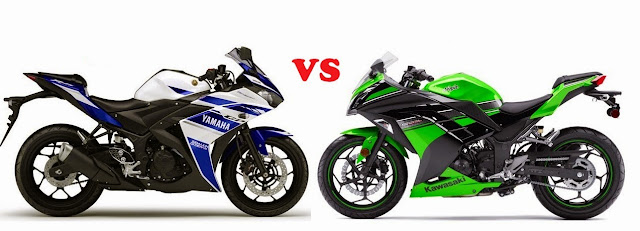Kawasaki Ninja 250 FI VS New Yamaha YZF-R25
Everybody knows the Yamaha already launch the Sport Bike in
250cc class. But is everybody know how well this bike on the track? Is it stiff
? How this bike accelerate ?
The only thing that we can do is battle it with the old
player in 250cc class, "The Kawasaki Ninja 250FI".
With similar machine specification, 2-cylinder DOHC 8 valve.
Let see the results!
Riding Position
Sitting in the seat are both fairly similar, although the
use handlebar clamp but it still has a comfortable sitting position. Not too
stiff for daily use.
The difference in R25 owned flatter handlebars, while Ninja
slightly bend downward.
The R25 has narrow and high tank, different with Ninja with medium
low and wide tank, but both of them are still equally comfortable. The next
difference is R25 soft rear suspension.
Handling and Performance
Let discuss about the handling. With a weight of only 166 kg
and the average distribution of 50:50 front-rear, R25 lighter and more agile to
maneuver, especially the angle turn the handlebars only 34 °. Ninja 250FI are a
lot heavier, with a weight reach 172 kg with a slightly wider turning radius.
When throttled up, R25 still win for this, because the 25 ° rake
angle and the 95 mm trail, makes it turning and maneuver so easily and accurate.
Ninja who had 27 ° rake angle and 93 mm trail, it took extra effort to take this
beast turn in the same speed, but you will get much and much comfortable when you
meet straight path.
The Characteristic of the suspension also influence to
handling, the rear suspension of R25 Mono cross are very soft, at high speed
rear wheel of R25 can easily moved. Differences with Ninja, uni-track mono
shock got slower compression but rebounded quickly, it makes you get a great
stability but when you met a bumpy road you will get shocked when you riding
Ninja.
About the performance, measured power on Dynojet 250i
dynamometer owned by Sportisi Motorsport Indonesia. Power of R25 reach 29.43 hp
/ 12,100 rpm and a torque of 19.2 Nm / 10,200 rpm. Medium Ninja 250FI 26.21 hp
/ 10,800 rpm and 17.87 Nm / 10,000 rpm. You can see it in the graph of dyno
results below.
As expected from the dyno test , we are trying to test it in
real condition. Ninja can only offset in the initial attraction 0-60 km / h
with a time of 3.1 seconds, after the R25 left with a gap between 0.2 to 0.5
seconds. You can see the details below. R25 Top speed was best to 170 km/h ,
the Ninja is only 161 km/h.
Acceleration Data
0-60 km / h: 3.1 seconds
0-80 km / h: 4.7 seconds
0-100 km / h: 7 seconds
0-100 m: 6.3 seconds
0-201 m: 9.7 seconds
0-402 m: 15.5 seconds
Tested Top speed: 158.4 km / h
0-60 km / h: 3.1 seconds
0-80 km / h: 4.9 seconds
0-100 km / h: 7.5 seconds
0-100 m: 6.4 seconds
0-201 m: 9.9 seconds
0-402 m: 15.7 seconds
Tested Top speed: 153.6 km / h
Gasoline consumption
Had the same engine configuration, the 250 cc 2-cylinder
DOHC 8 valve petrol supply injection and liquid-cooled. Bore x stroke both
overbore make better play at high rpm, then do not be surprised gasoline
consumption is quite greedy.
Both bike used daily on the streets of Jakarta (writer from Indonesia), with varying
road conditions produce gasoline consumption is not much different. R25 22.7 km
/ lt, while Ninja 250FI 21 km / lt.
Conclusion
If you are looking for comfort and stable riding for straight path area
you can pick the Ninja 250 FI as a great Beast, but if you are looking
for a bike for maneuvering racing Yamaha (Revs your Heart ) is the only candidate.
That's is our opinion. How about your opinion ?
source : www.motor.otomotifnet.com
Subscribe to:
Post Comments
(
Atom
)





No comments :
Post a Comment